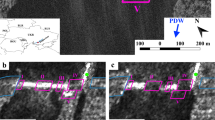Abstract
THE two-dimensional power spectra of ocean waves are of great interest not only to oceanographers but also in practical applications such as wave forecasting, trans-oceanic ship routing, and design of coast and offshore installations. Remote sensing of ocean surface waves can be difficult using conventional synthetic aperture radar (SAR) techniques, but waves can be observed clearly by SAR in the interferometric configuration (INSAR)1,2. This improvement is due to the ability of INSAR to provide images of the local surface velocity field, in contrast to conventional SAR for which the imaging process is related indirectly to the complex modulation of the surface reflectivity by longer waves and currents. Here we show that INSAR can be used to obtain wavenumber spectra that are in agreement with power spectra measured in situ. This new method thus has considerable potential to provide instantaneous spatial information about the structutre of ocean wave fields.
This is a preview of subscription content, access via your institution
Access options
Subscribe to this journal
Receive 51 print issues and online access
$199.00 per year
only $3.90 per issue
Buy this article
- Purchase on Springer Link
- Instant access to full article PDF
Prices may be subject to local taxes which are calculated during checkout
Similar content being viewed by others
References
Goldstein, R. M. & Zebker, H. A. Nature 328, 707–709 (1987).
Goldstein, R. M., Barnett, T. P. & Zebker, H. A. Science 246, 1282–1285 (1989).
Rice, S. O. Commun. pure appl. Math. 4, 351–378 (1951).
Crombie, D. D. Nature 175, 681–683 (1955).
Elachi, C. E. & Brown, W. E. IEEE Trans. Antennas Propagation AP-25, 84–95 (1977).
Harger, R. O. Synthetic Aperture Radar Systems (Academic, New York, 1970).
Raney, R. K. IEEE Trans. Aerosp. Electron. Syst. AES-7, 499–505 (1971).
Valenzuela, G. R. Boundary Layer Met. 13, 61–85 (1978).
Alpers, W. R., Ross, D. B. & Rufenach, C. L. J. geophys. Res. 86, 6481–6498 (1981).
Hasselmann, K. et al. J. geophys. Res. 90, 4659–4686 (1985).
Zimmerman, J. T. F. Geophys. astrophys. Fluid Dyn. 11, 34–47 (1978).
Valenzuela, G. R., Plant, W. J., Schuler, D. L., Chen, D. T. & Keller, W. C. J. geophys. Res. 90, 4931–4942 (1985).
Raney, R. K. & Lowry, R. T. Proc. 12th. Int. Symp. Remote Sensing Envir. 683–702 (1978).
Dean, R. G. & Dalrymple, R. A. Water Wave Mechanics for Engineers and Scientists (Prentice-Hall, Englewood Cliffs, 1984).
Author information
Authors and Affiliations
Rights and permissions
About this article
Cite this article
Marom, M., Goldstein, R., Thornton, E. et al. Remote sensing of ocean wave spectra by interferometric synthetic aperture radar. Nature 345, 793–795 (1990). https://doi.org/10.1038/345793a0
Received:
Accepted:
Issue Date:
DOI: https://doi.org/10.1038/345793a0
This article is cited by
-
A high-resolution handheld millimeter-wave imaging system with phase error estimation and compensation
Communications Engineering (2024)
-
Numerical simulation and validation of ocean waves measured by an Along-Track Interferometric Synthetic Aperture Radar
Chinese Journal of Oceanology and Limnology (2008)
Comments
By submitting a comment you agree to abide by our Terms and Community Guidelines. If you find something abusive or that does not comply with our terms or guidelines please flag it as inappropriate.



